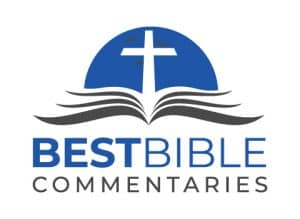Bible study aids are excellent tools that help people understand Scripture. While the information in them doesn’t replace the biblical text, like a great preacher or teacher, they make God’s Word easier to comprehend. Reference Bibles and Study Bibles are two such tools.
A reference Bible is a type of Study Bible that provides information about verses and passages of Scripture that relate to the primary text a person is studying or reading. References Bibles help readers understand how one verse or passage relates to another verse or passage in God’s Word.
What are some examples of the information Reference Bibles provide to readers? How can someone use a Reference Bible better? Should a person get a Reference Bible or a Study Bible for their personal Bible study? Keep reading to learn answers to these questions and many more.
Also, see the Study Bible Comparison Chart to quickly and easily compare dozens of them.

What Is a Reference Bible?
A reference Bible is a specific type of Bible edition that includes additional features to help readers study and cross-reference biblical passages. These features typically include a system of cross-references, footnotes, and explanatory notes to aid in understanding the text.
The purpose of a reference Bible is to enhance the study and understanding of the biblical text by providing tools and resources that facilitate cross-referencing, research, and exploration of the Scriptures. It is a valuable resource for individuals who wish to delve deeper into the richness and interconnectedness of the Bible’s teachings.
What Is a Study Bible?
A study Bible is a type of Bible edition that includes additional features and resources designed to assist readers in studying and understanding the biblical text. It provides a combination of the biblical text itself along with various tools and aids to aid in study, interpretation, and application.
The purpose of a study Bible is to provide readers with resources and tools to delve deeper into the study, interpretation, and application of the biblical text. It is particularly helpful for individuals who want to engage in more thorough and comprehensive Bible study, whether for personal devotion, academic study, or teaching purposes.
Reference Bibles vs. Study Bibles: Comparison Chart
Reference Bibles and study Bibles share several common features and purposes, despite having some distinct characteristics. While reference Bibles tend to focus primarily on cross-references and may have limited notes, study Bibles provide more extensive commentary, introductions, and other study aids.
| Reference Bibles | Study Bibles | |
|---|---|---|
| Purpose | to help readers understand God’s Word | to help readers understand God’s Word |
| Focus | supplying thousands of cross-references | supplying some cross-references, as well as information about history, theology, and application |
| Difference | some supply upwards of 50,000 cross-references | many include more than 10,000 references but less than 25,000 because they need room for articles on history, theology, and application |
| Readers | any Bible reader beginning to advance | any Bible reader, beginning to advanced |
| Translations | comes in the most popular English translations | come in most modern English translations |
Also, see Regular Bible vs. Study Bible to learn more.
What Are the Best Reference and Study Bibles?
A reader should choose a Reference Bible over a Study Bible if they only want a minimal amount of notes. Readers should choose a Study Bible over a Reference Bible if they want to learn about Scripture holistically, e.g., the historical settings, theological teachings, and relevance to the modern day.
The table below lists two of the best-reviewed Reference Bibles and four of the best-reviewed Study Bibles. The links provided go to Amazon using each book’s exact ISBN.
| References Bibles |
| KJV Thompson Chain Reference Bible |
| KJV Dake’s Annotated Reference Bible |
| Study Bibles |
| NIV Study Bible |
| ESV Study Bible |
| NIV Women’s Devotional Bible |
| KJV Life Application Bible |
What are cross-references in the Bible?
Cross references are verses or passages of Scripture that relate to another verse or practice of Scripture. Using cross-references helps readers understand biblical topics better and help them see the Bible as a complete book, as opposed to a disconnected collection of writings.
For example, if a Bible reader is studying the life of Peter in the Gospel of Matthew, they would have a complete picture of the Apostle if they also studied what Mark and Luke recorded about him. Cross references help readers find that information quickly and easily.
Consider Jesus’ rebuke of Peter for an example: “Peter took him aside and began to rebuke him. ‘Never, Lord!’ he said. ‘This shall never happen to you!'” (Matthew 16:22, NIV)
Mark 8:31-32 is a common cross-reference to Matthew 16:22 because it records the same story. A reader can gain more insight because there are two authors, each with a unique perspective and way of telling the story.
“He then began to teach them that the Son of Man must suffer many things and be rejected by the elders, the chief priests and the teachers of the law, and that he must be killed and after three days rise again. He spoke plainly about this, and Peter took him aside and began to rebuke him.” (Mark 8:31-32)
An example cross-reference from the writings of Paul
In Romans 3:23, Paul writes every single person — no matter their race, social class, gender, or the time in which they lived — has missed the mark with God. “For all have sinned and fall short of the glory of God.” (Romans 3:23, emphasis added)
Genesis 8:21 is a cross-reference to Romans 3:23 because it states that everyone has an evil heart from childhood.
“The Lord smelled the pleasing aroma and said in his heart: ‘Never again will I curse the ground because of humans, even though every inclination of the human heart is evil from childhood. And never again will I destroy all living creatures, as I have done.'” (Genesis 8:21, emphasis added)
Ecclesiastes 7:20 is another example of a cross-reference to Romans 3:23. “Indeed, there is no one on earth who is righteous, no one who does what is right and never sins.” (Ecclesiastes 7:20, emphasis added)
Also, see the Best Whole-Bible Commentaries to learn more.
Reference Bibles and Study Bibles Have Cross-References
All Study Bibles include cross-references, but they don’t have as many as Reference Bibles because they include other information. Instead of being the primary study feature like in Reference Bibles, cross-references are just one of many features in Study Bibles. Other feature Study Bible have include:
- Maps of regions, nations, cities, towns, waterways, and more
- Charts of kings, populations, weapons, mothers, animals, jewels, and more
- Timelines of individual lives, countries, wars, famines, missions work, the end times, and more
- Articles on doctrine and theology, biographies of biblical characters, social customs, and more
- Reading plans to help people read through the Bible in a year or through the Psalms in a month, as well as numerous other examples
- Study notes, often found at the bottom of each page, explain passages and verses, highlighting theology, history, and more
- Application suggestions so that readers can understand how passages and verses are relevant to them and their lives
When deciding between a Reference Bible and a Study Bible, it’s important to remember that one isn’t right and one isn’t wrong. Either one will help readers understand the Bible better. One solution that some people have found helpful is to have a Reference Bible and a Study Bible in their personal library!
Also, see the Best Commentary on Every Book of the Bible to learn more.
Related Questions
Whole Bible commentaries will help you understand every passage of Scripture better. If Bible commentaries on single books are like studying individual trees, whole-Bible commentaries will help you...
With so many Bible commentary series available today, many people want to know which ones are best. There is a wide variety of commentary series today because readers have various purposes for using...
